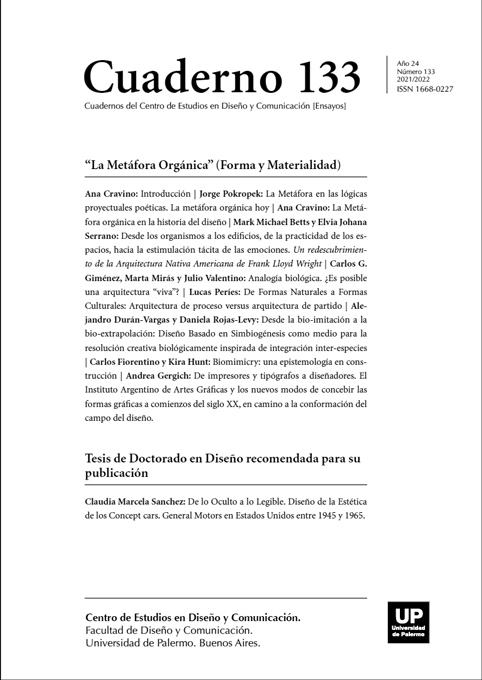Analogía biológica ¿Es posible una arquitectura “viva”?
Abstract
The relationship between architecture and biology is a long-established link in our disciplinary field. However, at present, in the field of architecture theory and practice, a series of novel terms emerge that are incorporated into language and actions in the discipline: biomimicry, evolutionary architecture, morphogenetic design, morphoecologies, protocell architecture, generative architecture and other derivatives of biological science. This article explores, based on our research – focused on analogical thinking and descriptive memories – the link between this binomial, its historical evolution and some questions of the most advanced state of the subject in contemporary times.
References
Boeri, S. (2020). Bosco Verticale. Recuperado de stefanoboeriarchitetti.net.
Cogdell, C. (2018). Toward a Living Architecture? Minneapolis: University of Minnesota Press.
Collins, P. (1977). Los ideales de la arquitectura moderna; su evolución (1750-1950). Barcelona: G. Gili.
Eisenman, P. (1988). Biocentro para la Universidad de Frankfurt. Arquitectura. Revista del Colegio Oficial de Arquitectos de Madrid. (270), pp. 83-91.
Fraile, M. (2019). Arquitectura Biodigital. Buenos Aires: Diseño Ed.
Giménez, C.; Mirás, M. y Valentino, J. (2011). La arquitectura cómplice. Buenos Aires: Nobuko.
Giménez, C.; Mirás, M. y Valentino, J. (2013). La analogía biológica desde la perspectiva de la teoría contemporánea. Jornadas de Crítica 185. IAA–FADU–UBA, Buenos Aires.
Hensel, M.; Menges, A. & Weinstock, M. (2010). Emergent technologies and design: towards a biological paradigm for architecture. Milton Park: Routledge.
Joachin, M.; Greden, L. & Arbona, J. (2008). Fab Tree Hab. Recuperado de https://www.archinode.com/fab-tree-hab
Kellert, S. & Wilson, E. O. (1993). The biophilia hypothesis. Washington: Island Press.
Kolarevic, B. (ed.) (2003). Architecture in the Digital Age: Design and Manufacturing. New York - London: Spon Press. Recuperado de www.i-m-a-d-e.org/fabrication/wp-content/uploads
Leach, N. (2009). Digital Morphogenesis. AD.Theorical Meltdown. Vol. 79 (1), pp. 32-37.
Mirás, M. (2011). Arquitectura y paisaje. Las viviendas del humedal del Bajo Delta Insular del Río Paraná. Jornadas de Crítica 170. IAA–FADU–UBA, Buenos Aires.
Nesbitt, K. (1996). Theorizing a New Agenda for Architecture. An Anthology of Architectural Theory. 1965-1995. New York: Princeton Architectural Press.
OCEAN NORTH & Scheffler + Partner (2006). Biblioteca Nacional Checa. Recuperado de ocean-designresearch.net.
Ockman, J. (2001). The Pragmatist Imagination. New York: Princeton Architectural Press.
Roudavski, R. (2009). Towards Morphogenesis in Architecture. International Journal of Architecture Computing. Vol. 7 (3).
Solà-Morales, I. (1995). Topografía de la arquitectura contemporánea. Barcelona: G. Gili.
Steadman, Ph. (1979 y 2008). The Evolution of Designs. Biological analogy in architecture and the applied arts. Cambridge: Cambridge University Press.
Sykes, A. K. (ed.) (2010). Constructing a New Agenda. Architectural Theory 1993 - 2009. New York: Princeton Architectural Press.
Vitruvio, M. (Trad. en 1992). Los Diez Libros de Arquitectura. Madrid: Ed. Akal.
Weinstock, M. (2004). Morphogenesis and the Mathematics of Emergence. AD. Emergence: Morphogenetic Design Strategies. Vol. 74 (3), pp. 10-17.
William, F. (2017). La dosis natural. Barcelona: Paidós.
Zaera, A. (1997). Una conversación con Peter Eisenman. Revista El Croquis,(83), pp. 6–20.
Los autores/as que publiquen en esta revista ceden los derechos de autor y de publicación a "Cuadernos del Centro de Estudios de Diseño y Comunicación", Aceptando el registro de su trabajo bajo una licencia de atribución de Creative Commons, que permite a terceros utilizar lo publicado siempre que de el crédito pertinente a los autores y a esta revista.


